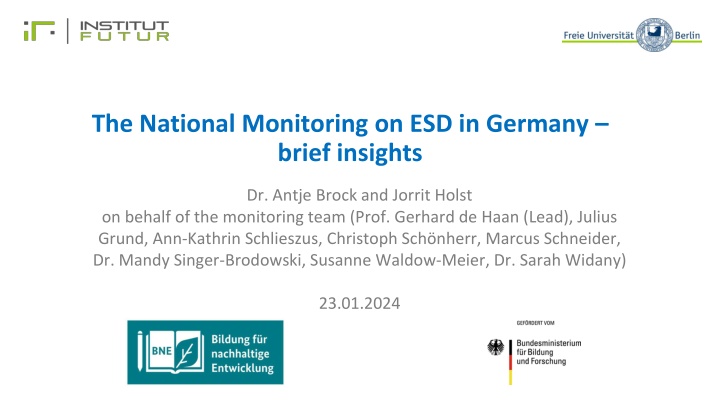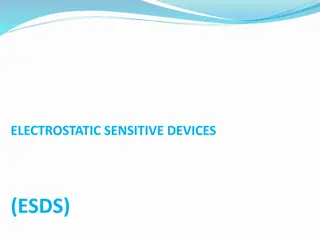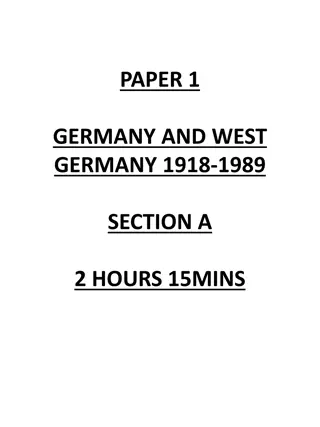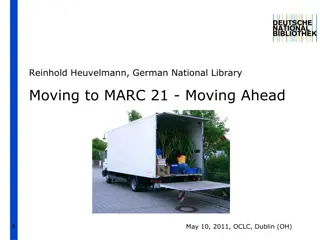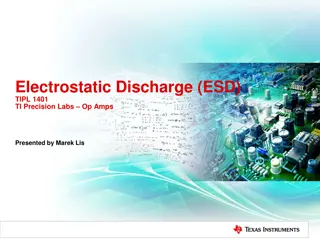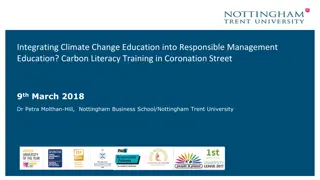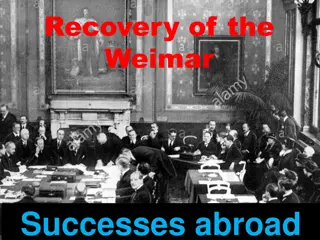Insights into the National Monitoring on ESD in Germany
Dr. Antje Brock and Jorrit Holst, on behalf of the monitoring team, provide insights into the National Monitoring on ESD in Germany. The monitoring aims to capture the quantity and quality of ESD in formal and non-formal learning settings, offering instruments for evaluation and contributing to the conception of effective ESD. Focal areas include addressing bottlenecks for good ESD, the socio-emotional dimension, and the importance of structural anchoring. Instruments are used for self-assessments and monitoring to assess the status quo and desired outcomes of ESD in Germany.
Download Presentation

Please find below an Image/Link to download the presentation.
The content on the website is provided AS IS for your information and personal use only. It may not be sold, licensed, or shared on other websites without obtaining consent from the author.If you encounter any issues during the download, it is possible that the publisher has removed the file from their server.
You are allowed to download the files provided on this website for personal or commercial use, subject to the condition that they are used lawfully. All files are the property of their respective owners.
The content on the website is provided AS IS for your information and personal use only. It may not be sold, licensed, or shared on other websites without obtaining consent from the author.
E N D
Presentation Transcript
The National Monitoring on ESD in Germany brief insights Dr. Antje Brock and Jorrit Holst on behalf of the monitoring team (Prof. Gerhard de Haan (Lead), Julius Grund, Ann-Kathrin Schlieszus, Christoph Sch nherr, Marcus Schneider, Dr. Mandy Singer-Brodowski, Susanne Waldow-Meier, Dr. Sarah Widany) 23.01.2024
Overview 1. Context and Structure ESD-Monitoring 2. Some focal areas of action 3. Instruments
Aims and conception of the ESD-Monitoring Capturing quantity & quality of ESD in Germany (formal & non-formal learning settings) Supportive-facilitative monitoring: aiming to increase both dimensions Independent monitoring at the science-policy interface Offering instruments for (self-)evaluation Empirically based contributing to conception of ESD: What is good and effective ESD? Transdisciplinarity: exchange with researchers, practitioners, administrative level (e.g. Document Analysis, Reflexive Monitoring in Action (RMA), Expert Study on Competencies for SDG 4.7)
Some focal areas of action Bottlenecks for good ESD: Qualification of multiplicators Agency of learners (misfit: problem size and available solutions hopelessness, negative emotions) Importance of socio-emotional dimension of ESD Importance of material setting/ context of learning Whole Institution Approach Type of structural anchoring: Integration / Redesign instead of Add-on
Instruments for (self-)assessments - structural anchorage of ESD (input-level) Monitoring SDG 4.7.1 at the input-level: Assessing structural anchorage of ESD (documents) in different educational areas, based on > 11.000 documents (Holst, Singer-Brodowski, Brock, de Haan 2024)
Status quo vs. desired ESD-quantity Learners Multiplicators Wish Wish Status Quo Status Quo (Grund & Brock, 2022) Status Quo: What percentage of the total teaching time at your [educational institution: school, university) currently makes clear reference to the topic of sustainable development? Wish: In an ideal educational institution that fully meets your expectations: In what percentage of your total teaching/studies are there clear references to the topic of sustainable development?" (0% = no references, 100% = clear references everywhere)
Instruments for (self-)assessments Whole Institution Approach Development and application of WIA-Scale; assessment with> 2.500 learners and > 500 educators (Holst, Grund & Brock, in review)
References: Grund, J. & Brock, A. (2022): Formale Bildung in Zeiten von Krisen die Rolle von Nachhaltigkeit in Schule, Ausbildung und Hochschule. Institut Futur, Freie Universit t Berlin. Holst, J., Grund, J. & Brock, A (in review): Whole Institution Approach: Measurable and highly effective in empowering learners and educators for sustainability. Holst, J., Singer-Brodowski, M., Brock, A., & de Haan, G. (2024). Monitoring SDG 4.7: Assessing Education for Sustainable Development in policies, curricula, training of educators and student assessment (input-indicator). Sustainable Development, 1 16.
